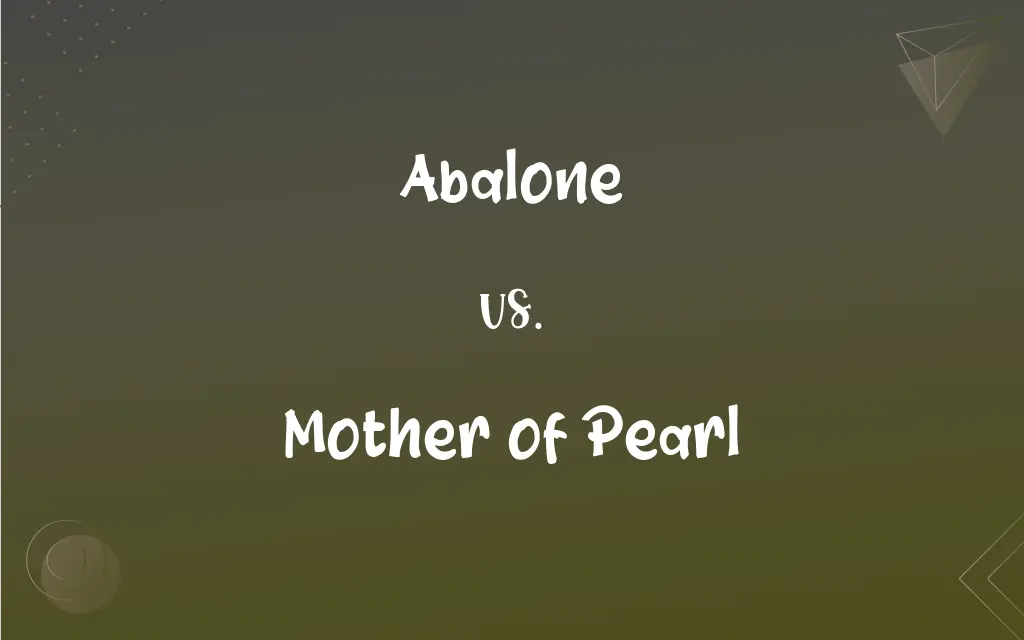Abalone vs. Mother of Pearl: What's the Difference?
Edited by Aimie Carlson || By Harlon Moss || Published on December 13, 2023
Abalone is a type of marine mollusk known for its colorful shell; Mother of Pearl is the iridescent lining found inside various mollusk shells, including abalone.

Key Differences
Abalone are marine mollusks with a distinct, often colorful, and ear-shaped shell. They are found in various oceans and are known for their edible meat. Mother of Pearl, also known as nacre, is a smooth, iridescent substance that forms the inner layer of the shells of mollusks, including abalone, used in decorative and jewelry-making applications.
Abalone is primarily valued for its meat in culinary contexts and is also appreciated for its shell in decorative arts. The shell's unique coloring and patterns are a result of the mollusk's diet and environment. Mother of Pearl is sought after for its aesthetic qualities, particularly its shimmering appearance and texture, which is used in various decorative objects and jewelry.
Abalone live in coastal waters and are often harvested for food and their shells. They play an ecological role in their marine environments. Mother of Pearl is harvested as a byproduct of mollusk cultivation or collection, prized in the creation of various artistic and fashion items.
Abalone shells are composed of calcium carbonate and a protein that makes them strong and resilient. They are often polished to reveal their natural iridescence. Mother of Pearl is the same material that constitutes the innermost layer of these shells, valued for its luster and used in inlay work.
Abalone has cultural significance in many coastal communities, used in traditional ceremonies and crafts. The harvesting of abalone is regulated to prevent overfishing. Mother of Pearl has been used historically in various cultures for ornamentation, symbolizing wealth and luxury.
ADVERTISEMENT
Comparison Chart
Type
A marine mollusk with a distinctive shell.
The iridescent inner layer of mollusk shells.
Use
Culinary delicacy; shell used in arts.
Used in jewelry, decoration, and inlay work.
Source
Harvested from oceans and coastal waters.
Harvested from the shells of mollusks, including abalone.
Composition
Shell made of calcium carbonate and protein.
Composed of the same materials as the abalone shell, but specifically the inner layer.
Cultural Significance
Important in coastal cuisines and traditional crafts.
Historically symbolizes wealth and luxury in various cultures.
ADVERTISEMENT
Abalone and Mother of Pearl Definitions
Abalone
Abalone is a type of edible marine snail with a distinctive, colorful shell.
The restaurant's special tonight is grilled abalone with herbs.
Mother of Pearl
Mother of Pearl, or nacre, is a natural material valued in fine art.
The artist used mother of pearl inlays to create the intricate mosaic.
Abalone
Abalone is known for its iridescent shell and flavorful meat.
She added abalone slices to the seafood pasta for a luxurious touch.
Mother of Pearl
Mother of Pearl is known for its lustrous, shimmering qualities.
The mother of pearl tiles gave the room an elegant, opulent feel.
Abalone
Abalone, a marine delicacy, is also a subject of conservation due to overfishing.
Regulations have been introduced to sustainably manage abalone fishing.
Mother of Pearl
Mother of Pearl has been used historically in luxury goods and ornamentation.
The museum displayed a collection of historical mother of pearl artifacts.
Abalone
Abalone refers to a group of large, ear-shaped sea mollusks.
Divers harvested abalone off the rocky coastline.
Mother of Pearl
Mother of Pearl is used for decorative purposes in jewelry and crafts.
Her necklace featured a stunning mother of pearl pendant.
Abalone
Abalone are sought after for both gastronomy and decorative shell art.
His collection of abalone shells was a highlight in the art exhibition.
Mother of Pearl
Mother of Pearl is the iridescent lining found inside mollusk shells.
The antique box was inlaid with mother of pearl.
Abalone
Any of various large edible marine gastropods of the genus Haliotis, having an ear-shaped shell with a row of holes along the outer edge. The colorful pearly interior of the shell is often used for making jewelry or other ornaments. Also called ear shell.
Mother of Pearl
The pearly internal layer of certain mollusk shells, used to make decorative objects. Also called nacre.
Abalone
An edible univalve mollusc of the genus Haliotis, having a shell lined with mother-of-pearl.
Mother of Pearl
The hard pearly inner layer of certain mollusk shells; nacre.
Abalone
The meat of the aforementioned mollusc.
Mother of Pearl
A butterfly of the genus Salamis.
Abalone
A univalve mollusk of the genus Haliotis. The shell is lined with mother-of-pearl, and used for ornamental purposes; the sea-ear. Several large species are found on the coast of California, clinging closely to the rocks.
Mother of Pearl
Made from or looking like mother-of-pearl; iridescent or pearly.
Abalone
Any of various large edible marine gastropods of the genus Haliotis having an ear-shaped shell with pearly interior
Mother of Pearl
The hard, iridescent, pearly internal layer of several kinds of shells, esp. of pearl oysters, river mussels, and the abalone shells; nacre. See Pearl.
Mother of Pearl
The iridescent internal layer of a mollusk shell
FAQs
Can you eat mother of pearl?
No, mother of pearl is not edible; it's used for decorative purposes.
What is abalone?
Abalone is a type of edible sea mollusk, known for its colorful shell.
Are abalone and mother of pearl expensive?
Both can be expensive due to their desirability in culinary and decorative contexts.
Is abalone farming sustainable?
When managed properly, abalone farming can be a sustainable practice.
Why is mother of pearl prized in jewelry making?
Its iridescence and luster make it highly valued in jewelry.
How is abalone harvested?
Abalone is harvested from the ocean, either through diving or in abalone farms.
What are the uses of mother of pearl?
It's used in jewelry, inlays, and other decorative items.
Can mother of pearl be artificially created?
Artificial mother of pearl exists, but it doesn't match the quality of the natural form.
Is abalone shell the same as mother of pearl?
Abalone shell contains mother of pearl as its inner lining, but they are not the same; the outer shell is less iridescent.
How is mother of pearl harvested?
It's harvested from the inner lining of mollusk shells, often as a byproduct of mollusk harvesting.
What is mother of pearl?
Mother of pearl is the iridescent inner layer of the shell of certain mollusks, including abalone.
What cuisines feature abalone?
Abalone is featured in various Asian and coastal cuisines.
How do you identify genuine abalone?
Genuine abalone has a distinctive pattern and iridescence in its shell.
Is abalone shell used in traditional practices?
Yes, many cultures use abalone shells in traditional ceremonies and crafts.
What makes mother of pearl unique in art?
Its unique luster and iridescence make it a favorite in art and decoration.
What are the environmental concerns with abalone harvesting?
Overharvesting and habitat destruction are major concerns.
Are there ethical concerns with mother of pearl?
Ethical concerns arise from the potential overharvesting of mollusks.
Can mother of pearl vary in color?
Yes, it can vary from white and silver to pink and green, depending on the mollusk.
Can abalone be cooked in various ways?
Yes, it can be grilled, sautéed, or used in soups and stews.
What is the texture of abalone meat?
Abalone meat is firm and slightly chewy, with a mild flavor.
About Author
Written by
Harlon MossHarlon is a seasoned quality moderator and accomplished content writer for Difference Wiki. An alumnus of the prestigious University of California, he earned his degree in Computer Science. Leveraging his academic background, Harlon brings a meticulous and informed perspective to his work, ensuring content accuracy and excellence.
Edited by
Aimie CarlsonAimie Carlson, holding a master's degree in English literature, is a fervent English language enthusiast. She lends her writing talents to Difference Wiki, a prominent website that specializes in comparisons, offering readers insightful analyses that both captivate and inform.






































































